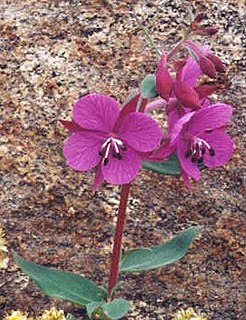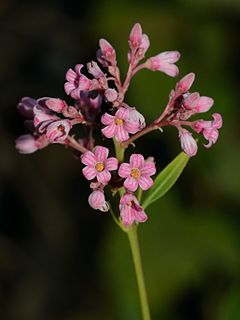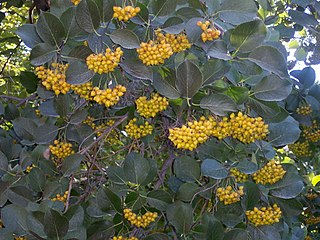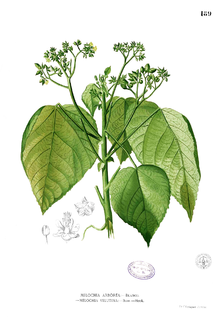
Convolvulaceae, known commonly as the bindweed or morning glory family, is a family of about 60 genera and more than 1,650 species of mostly herbaceous vines, but also trees, shrubs and herbs, and also including the sweet potato and a few other food tubers.

The Scrophulariaceae are a family of flowering plants, commonly known as the figwort family. The plants are annual and perennial herbs, as well as one genus of shrubs. Flowers have bilateral (zygomorphic) or rarely radial (actinomorphic) symmetry. The Scrophulariaceae have a cosmopolitan distribution, with the majority found in temperate areas, including tropical mountains. The family name is based on the name of the included genus Scrophularia L.

Ampelopsis, commonly known as peppervine or porcelainberry, is a genus of climbing shrubs, in the grape family Vitaceae. The name is derived from the Ancient Greek: ἅμπελος (ampelos), which means "vine". The genus was named in 1803. It is disjunctly distributed in eastern Asia and eastern North America extending to Mexico. Ampelopsis is primarily found in mountainous regions in temperate zones with some species in montane forests at mid-altitudes in subtropical to tropical regions. Ampelopsis glandulosa is a popular garden plant and an invasive weed.

The Onagraceae are a family of flowering plants known as the willowherb family or evening primrose family. They include about 650 species of herbs, shrubs, and trees in 17 genera. The family is widespread, occurring on every continent from boreal to tropical regions.

Nyctaginaceae, the four o'clock family, is a family of around 33 genera and 290 species of flowering plants, widely distributed in tropical and subtropical regions, with a few representatives in temperate regions. The family has a unique fruit type, called an "anthocarp", and many genera have extremely large pollen grains.

Brosimum is a genus of plants in the family Moraceae, native to tropical regions of the Americas.

Colubrina is a genus of about 30 species of flowering plants in the family Rhamnaceae, native to warm temperate to tropical regions of Africa, the Americas, southern Asia, northern Australia, and the Indian Ocean islands. Common names include nakedwood, snakewood, greenheart and hogplum. The generic name is derived from the Latin word coluber, meaning "snake", and refers to the snake-like stems or stamens.

Sicyos is a flowering plant genus of the family Cucurbitaceae. Members of the genus are commonly known as burr cucumbers.

Bursera is a genus with about 100 described species of flowering shrubs and trees varying in size up to 25 m (82 ft) high. It is the type genus for Burseraceae. The trees are native to the Americas, from the southern United States south through to northern Argentina, in tropical and warm temperate forest habitats. It is named after the 17th-century Danish botanist Joachim Burser.

Apocynoideae is a subfamily of the flowering plant family Apocynaceae. It contains about 78 genera with roughly 860 species. Several genera are of pharmacological interest - notably those - such as Strophanthus - which have furnished highly effective arrow poisons, due to their cardiac glycoside content. The subfamily includes many species with flowers of considerable ornamental value, the best-known of which is Nerium oleander, the familiar Oleander. It also contains the remarkable pachycaul genera Adenium and Pachypodium.

Bourreria is a genus of flowering plants in the borage family, Boraginaceae. Members of the genus are commonly known as strongbark or strongback. The generic name was chosen by Patrick Browne to honour German pharmacist Johann Ambrosius Beurer. The genus is native to the Americas, where species are distributed from Mexico to northern South America, and in the Caribbean and Florida in the United States. The center of diversity is in the Caribbean, Central America, and Mexico.

Casearia is a plant genus in the family Salicaceae. The genus was included in the Flacourtiaceae under the Cronquist system of angiosperm classification, and earlier in the Samydaceae. Recent research indicates that the latter group might be reinstated as a valid family.
Gyminda is a genus of flowering plants in the family Celastraceae.

Hamelia is a genus of flowering plants in the coffee family, Rubiaceae. The name honors French botanist Henri-Louis Duhamel du Monceau (1700–1782).

Uvaria is a genus of flowering plants in the soursop family, Annonaceae. The generic name uvaria is derived from the Latin uva meaning grape, likely because the edible fruit of some species in the genus resemble grapes.
Schaefferia is a genus of flowering shrubs and small trees in the family Celastraceae. The generic name honours German mycologist and clergyman Jacob Christian Schäffer (1718–1790). Members of the genus are found in the Neotropics. The plants are dioecious, with flowers that are unisexual by abortion. The flowers are usually clustered in the leaf axil, although they are solitary in some species. The calyx of the flowers has four lobes, and the corolla consists of four petals. The ovary consists of two locules; each locule has a single ovule which develops into a single seed. The fruit is a drupe.

Heteranthera is a genus of aquatic plants in the water hyacinth family, Pontederiaceae, known generally as mud plantains. Species of this genus are native to tropical and subtropical America and Africa. They live in the water or in wet soils. They produce leaves on long petioles and some are cultivated for their attractive flowers. Leaves are of two types - linear and submerged or orbicular and floating. Some species have cleistogamic flowers.

Ehretioideae is a subfamily of the flowering plant family Boraginaceae.

Portlandia is a genus of flowering plants in the coffee family, Rubiaceae. Members of the genus are endemic to Jamaica.

Melochia is a genus of flowering plants in the mallow family, Malvaceae. It comprises 54 species from the tropical and subtropical regions of the world, ranging from India eastwards through Malesia and the Pacific Islands to the Americas and the Caribbean.

















